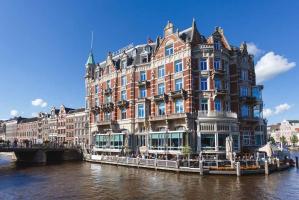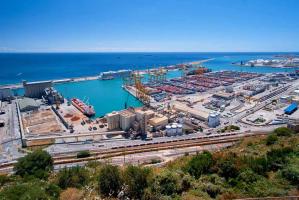Amsterdam bans creation of new hotels
Another piece in the overall strategy to reduce tourist flows to the city
 TheMayor.EU logo
TheMayor.EU logo 
An EU project built apartments in southwestern France to showcase wood's potential in construction, Source: © Rémi Lamouret, Department of Gironde
Forests in the EU can help green the European construction industry and bolster a continent-wide push for architectural improvements.
By Jessica Berthereau
In France’s southwestern Gironde department, where half the area is covered by forests, authorities in 2022 built a secondary school with wood from local pine trees.
The Pian-Médoc school, located between the city of Bordeaux and some of France’s most famous vineyards, reflects a push to find practical uses for wood from nearby trees while protecting forests.
The aim was to preserve the existing trees as much as possible and to repurpose those that inevitably had to be cut down,’ said Maxim Peveri, a project manager at the Gironde department.
The department became a central part of a Europe-wide research project that received EU funding to promote the use of wood, which is both a versatile and a recyclable material. Called BASAJAUN, the project is due to end this month after four and a half years.
The flagship result of the initiative is a wooden apartment building that is located adjacent to the Pian-Médoc school and will house some staff members. The two-storey structure with 16 flats highlights how forest resources can aid rural areas, be sustainably managed and help green the construction industry.
This building serves as a demonstration showcase,’ said Dr Javier García Jaca, coordinator of BASAJAUN and a project director at the Tecnalia Research and Innovation Foundation in Spain.
The building, due to be inaugurated in April 2024, is made of non-local wood from Spanish and Swedish suppliers of pine, poplar and spruce.
The facade was designed to be disassembled for reuse. It consists of a bio-composite frame, structural insulated panels and a cladding. The panels are plywood boards with natural wood fibre as the insulation material instead of the usual synthetic foam.
While having the same required technical properties as synthetic foam, natural wood fibre is less polluting.
The facade was made by an Italian company named Focchi and the insulation panels were manufactured by Spain-based Garnica. Sweden-based Moelven supplied the wood for the internal structure beams. All three companies are partners in BASAJAUN.
‘This building stands as proof that we can transform and improve the construction sector, which has a very high environmental impact,’ said García Jaca.
BASAJAUN advances one of the European Green Deal’s goals of profoundly transforming production to achieve climate neutrality, including in rural areas.
And connecting the European Green Deal to people’s daily lives and living spaces is the New European Bauhaus initiative, which fuses architecture with sustainability, aesthetics and inclusion. The EU is organising an NEB festival in the Belgian capital Brussels on 9-13 April.
In the EU, buildings are responsible for around 40% of energy consumption and 35% of greenhouse-gas emissions.
Furthermore, traditional building materials such as concrete and steel are themselves energy-intensive, adding to the greenhouse-gas emissions that cause climate change.
By contrast, trees mitigate climate change by storing carbon dioxide (CO2) from the atmosphere when they grow. And wood used in construction continues to store CO2, reducing the carbon footprint of the building industry.
By incorporating more wood, buildings can lower emissions and even become carbon sinks,’ said García Jaca.
Around 39% of the EU land area – or 159 million hectares – is covered by forests, making them a valuable domestic source of building materials.
The EU goal is to ensure that wood is sourced sustainably. That means managing forests in a way that promotes biodiversity, protects ecosystems and supports local communities.
The carbon storage potential of new residential wood buildings in the EU – if the opportunity to build them were fully exploited – is 55 million tonnes a year, according to BASAJAUN.
That’s equivalent to the annual emissions of more than 12 million petrol-powered passenger cars.
Bio-based materials including wood account for just 3% of the mass of building material used in Europe, according to a 2022 report. Of that share, wood accounts for two-thirds.
BASAJAUN has brought together partners from 11 EU countries stretching from Finland to Portugal. It includes one non-EU participant – a university from Chile.
Besides the apartment building near Bordeaux, the project has developed a system for digitally tracking wooden materials used in construction from start to finish.
Identifying all the steps in the supply chain – beginning with an individual tree and ending with a specific item in a building – promises a clearer picture of the economic, environmental and social benefits of wood, according to the project.
To ensure the wood sector’s voice is heard within the New European Bauhaus, the BASAJAUN team has forged an industry alliance called Wood4Bauhaus.eu.
Other EU-funded researchers are seeking to ensure that more used wood in Europe gets recycled.
Their project, called WOODCIRCLES, estimates that less than half of European wood waste – 50 million tonnes a year – is being recycled at present. The project runs for four years through May 2027.
Wood waste consists of non-virgin timber such as shavings, chippings and large, intact pieces. It gets used by companies in what is known as the particle board industry.
The main challenge with wood waste is its highly variable quality, according to Dr Anders Kjellow, the coordinator of WOODCIRCLES and centre project manager at the Danish Technological Institute near Copenhagen.
Dismantling a building can result in a large pile of wood in various shapes and sizes, potentially mixed with metals and substances or even showing signs of rot,’ he said.
The particle board industry addresses this challenge by grinding everything down into small particles. These are then glued and pressed together to make a low-cost product that is mainly for non-load-bearing applications.
The WOODCIRCLES team will try to find a way to reuse large pieces of wood without going through the whole process of grinding them down into particles and using those to make load-bearing construction products.
The pan-European project has brought together 20 organisations covering the entire wood-construction value chain. They include architects, developers, contractors, timber suppliers, academics and digital designers.
Our aim is to create complementary value chains to minimise waste and resource consumption,’ said Kjellow.
WOODCIRCLES also has a strong design focus.
It’s working on a wood-based building system that can be disassembled for easy re-use, according to Kjellow. The idea is to think about reusing wood from the start to avoid the current bottleneck caused by wood waste.
Wood epitomises sustainable material,’ he said. ‘It’s imperative that we also use it in a sustainable manner.’
That’s why, decades from now when the wooden apartment building near Bordeaux is decommissioned, its facade will be easily dismantled and the components given a new life in another construction.
This article was originally published in Horizon the EU Research and Innovation Magazine. The publication has been edited for length as part of an agreement.

Legislators and magnates have to await a preliminary ruling from the European Court of Justice

The building will then serve as the site for a new museum dedicated to Finnish-Russian relations

Another piece in the overall strategy to reduce tourist flows to the city

In addition, the federal government has launched the National Week of Action against Bicycle Theft to raise awareness of the issue and the new solution

The facility will replace the need to have water supplied by tankers from Valencia

Modern traffic lights do more than regulate the flow of vehicles at crossroads, they also collect enormous amounts of data

Experimenting with public transport provision in Germany is clearly in a state of creative fervour

Legislators and magnates have to await a preliminary ruling from the European Court of Justice

It also set the standards for a better European parking card for people with disabilities

The benefit will last until the Dutch parliament adopts the transgender law

Experimenting with public transport provision in Germany is clearly in a state of creative fervour

It also set the standards for a better European parking card for people with disabilities

Urban dwellers across the EU are having a say in making their surroundings friendlier to people and the environment.

Forests in the EU can help green the European construction industry and bolster a continent-wide push for architectural improvements.

Apply by 10 November and do your part for the transformation of European public spaces

Catch up with some recommendations for the 2024 European Capital of Culture programme from the mayor of Tartu

An interview with the ICLEI regional director for Europe аfter the close of COP28

An interview with a member of the No Hate Speech Network team













